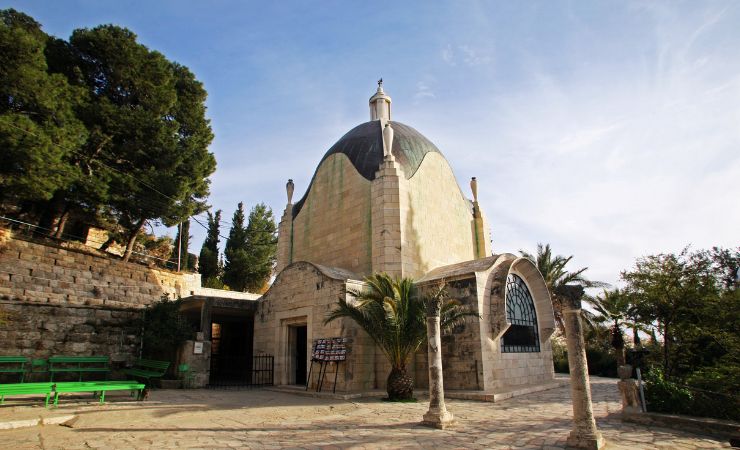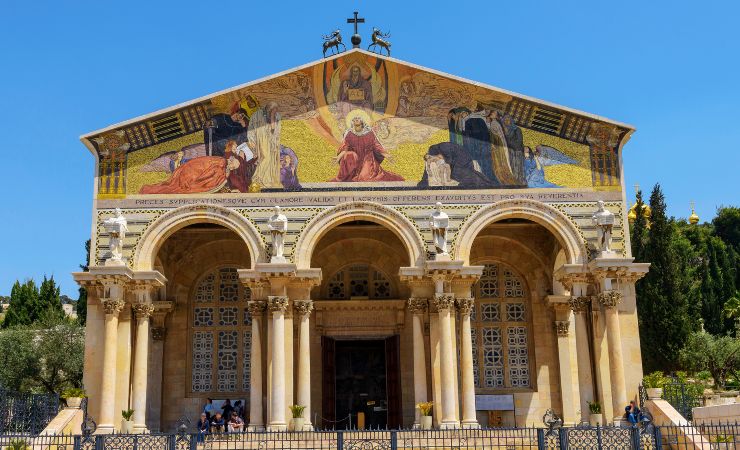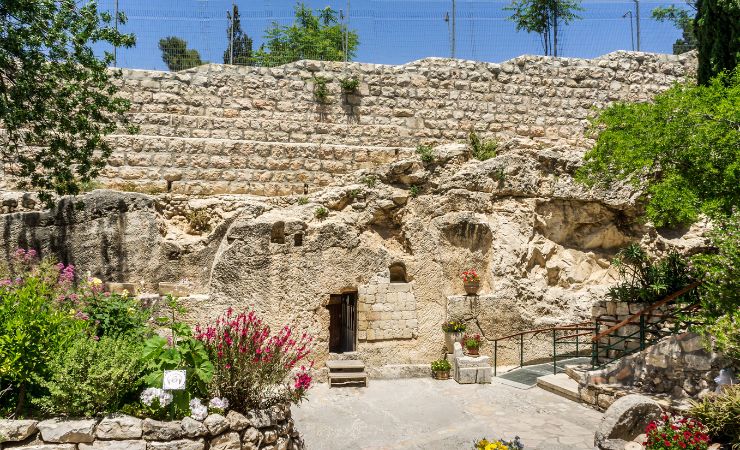Antonio Barluzzi: The Architect of the Holy Land
Originally published: July 2023 | Last updated: May 2025
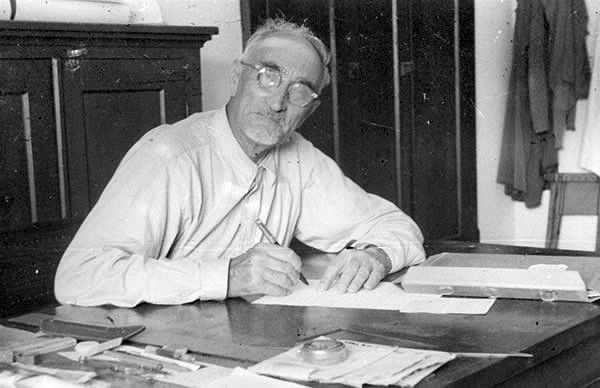
Early Life and Formative Years
Antonio Barluzzi was born on September 26, 1884, in Rome, Italy, into a family with a lineage in sacred architecture. His maternal grandfather was responsible for the maintenance of St. Peter’s Basilica, which likely had an impact on Barluzzi’s choice of career.
As a young man, Barluzzi was deeply religious and considered entering the seminary to become a priest. However, his spiritual mentor advised him against it, suggesting that he could serve his faith through other means. His elder brother Giulio, who was already an architect, also played a role in influencing his career choice.
Antonio Barluzzi then embarked on his studies in architecture at a renowned engineering school. His education was characterized by a keen interest in historical architectural styles, especially those related to religious buildings. Barluzzi’s early designs already showed a predilection for integrating historical elements with modern architectural practices.
Military Service and a Turning Point
Between 1909 and 1914, Antonio Barluzzi worked on construction projects with his brother Giulio in both Italy and the Middle East. During this period, while still exploring a possible religious vocation, he found himself in Jerusalem working on a hospital project. It was then that he first came into contact with the Franciscan Custody of the Holy Land. Father Razzoli, a member of the Custody, asked him to submit architectural plans for a basilica on Mount Tabor.
The outbreak of World War I in 1914 interrupted his work, and Barluzzi returned to Italy. After briefly reconsidering entering the seminary, he instead joined the Italian army in 1915, serving as a Sergeant in the Fortifications Office. His duties included overseeing archaeological excavations at Castel Sant’Angelo in Rome. In 1918, he joined the Italian detachment in Palestine and was present during the Allied entry into Jerusalem.
While still in Mandatory Palestine, Barluzzi met Father Ferdinando Diotallevi, the new head of the Franciscan Custody. Diotallevi had seen the plans Barluzzi had previously prepared for Mount Tabor and invited him to begin work on that church, along with a new one at Gethsemane.
Barluzzi initially hesitated, aware of the scale and responsibility of designing two major churches. He returned to Italy to reflect on the offer. Ultimately, he chose to accept the task and returned to Jerusalem, committed to moving forward.



Beginning of a Lifelong Dedication
In the early 1920s, the Franciscans entrusted Barluzzi with the task of designing and building churches atop the ruins of ancient Byzantine and Crusader churches in the Holy Land. This marked the beginning of his lifelong dedication to sacred architecture in the Holy Land.
He arrived in British Mandate Palestine with a mission to rebuild and restore sacred Christian sites. His first major projects included the Church of the Transfiguration on Mount Tabor and the Church of All Nations in the Garden of Gethsemane, both of which established him as a visionary architect.
The Church of the Annunciation and Later Years
One of Barluzzi’s designs that did not materialize was for the Church of the Annunciation in Nazareth. Despite his prolific contributions, the church authorities chose Giovanni Muzio’s design over Barluzzi’s. This deeply affected him.
Barluzzi spent his last years in a small apartment in Rome and passed away in 1960. His final resting place is in the cemetery of the Franciscan Custody of the Holy Land, next to Mount Zion.
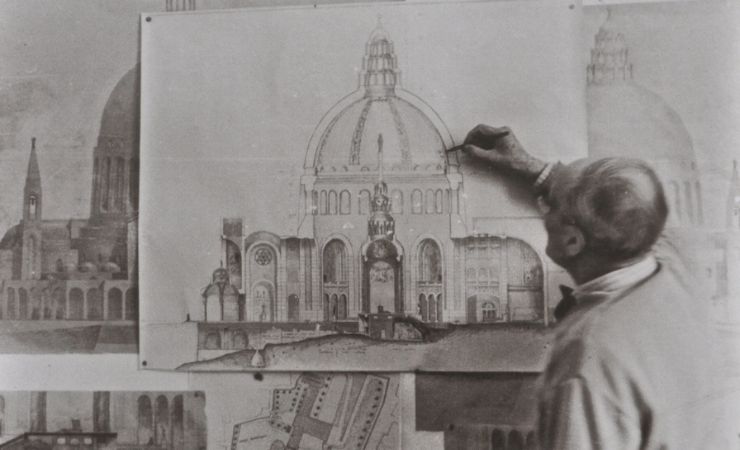
Antonio Barluzzi's Legacy
Antonio Barluzzi’s work in the Holy Land is monumental. Through his architecture, he not only preserved the religious heritage of Christianity but also enriched it. His buildings are visited by countless pilgrims and tourists from around the world. He is often referred to as the “Architect of the Holy Land” for his significant contributions in shaping the architectural landscape of sacred Christian sites.
Though he may not have gained extensive international fame during his lifetime, Barluzzi’s legacy continues to grow posthumously as more people discover and appreciate his architectural masterpieces that so beautifully combine the historical and spiritual essences of Christianity.
His work stands as a testament to his devotion and love for the Holy Land and his unwavering faith. The churches he designed and built are not only places of worship but also historical treasures that connect the past and present for many Christians.
Antonio Barluzzi’s story is one of passion, dedication, and a deep connection to the sacred sites he helped to reinvigorate. Through his vision and architectural skill, he managed to capture the spirit and history of the Holy Land in his designs, leaving a lasting legacy for future generations to cherish.
His work continues to inspire architects and individuals interested in sacred architecture, and his contribution to the preservation of Christian heritage in the Holy Land remains invaluable.
Antonio Barluzzi's Work in the Holyland
Churches
The Church of All Nations in the Garden of Gethsemane, Jerusalem (1919-1924): Built between 1919 and 1924, the Church of All Nations, also known as the Basilica of the Agony, is located at the foot of the Mount of Olives in Jerusalem. It enshrines a section of bedrock where Jesus is believed to have prayed before his arrest. The church’s name reflects the contributions made by many countries to its construction. Its façade features a mosaic depicting Christ as the link between God and humanity.
The Church of the Transfiguration, Mount Tabor (1921-1924): This church is situated on Mount Tabor, a site traditionally believed to be the location of the Transfiguration of Jesus. The church is built on the ruins of Byzantine and Crusader churches, incorporating light-colored limestone and Syrian architectural elements. It features three grottoes representing the huts that Peter desired to build for Jesus, Moses, and Elias.
The Church of the Hospice of the Good Shepherd, Jericho (1924-1925): Located in the ancient city of Jericho, this church was constructed as a hospice and place of worship for Christian pilgrims visiting the Holy Land.
The Church of the Flagellation, Jerusalem (restoration 1927-1929): This church, traditionally believed to be the site where Jesus was scourged, was restored by Barluzzi.
The Church of the Holy Sepulchre, Jerusalem (restoration of the Catholic Chapel of Calvary, 1933-1937): The impressive Catholic gallery, represents the 12th station of the Via Dolorosa. It is the place where Jesus is traditionally believed to have been nailed to the cross.
The Church of the Beatitudes, Galilee (Completed 1938): This church is situated on the Mount of Beatitudes, where Jesus is believed to have delivered the Sermon on the Mount. The church has an octagonal shape, reflecting the eight Beatitudes, has a spectacular view of the Sea of Galilee and is surrounded by gardens.
The Church of the Visitation, Ein Karem (completed 1955): This church in Ein Karem commemorates the visitation of Mary to Elizabeth. Barluzzi designed the church in a Renaissance style, with a façade of arches and intricate interior mosaics depicting the visitation and Magnificat.
The Cloister of Bethlehem (restoration, completed 1947): The restoration of the Cloister of Bethlehem by Barluzzi involved preserving the historical integrity of the structure while ensuring its stability and usability for religious purposes.
The Church of St. Lazarus, Bethany (completed 1953): This church, built on the traditional site of Lazarus’ house, combines Byzantine and Romanesque architectural styles. It features a bell tower and an elegant interior.
The Church of the Angels, Shepherds Fields, Bethlehem (completed 1954): This church, built in the shape of a tent, commemorates the appearance of the angels to the shepherds announcing Jesus’ birth. Its simple design reflects the humble settings of the biblical event.
Dominus Flevit, Mount of Olives (completed 1955): Dominus Flevit, which means “The Lord Wept,” is a small church shaped like a teardrop, symbolizing the tears of Christ. It is situated on the Mount of Olives, where Jesus wept over Jerusalem.
The Church at Bethphage (restoration, 1955): This restoration project involved carefully preserving and enhancing the church at Bethphage, the traditional starting point of Jesus’ triumphal entry into Jerusalem.
The Greek Church of the Holy Face and St. Veronica, Jerusalem (restoration): In this restoration project, Barluzzi worked on the Greek Church of the Holy Face and St. Veronica in Jerusalem, preserving its historical integrity and religious significance.
Other buildings and structures
- The Italian Hospital of Jerusalem (1912-1919): Beluzzi and his brother created a beautiful building (that currently houses offices of the Ministry of Education) that consists of a harmonious blend of Italian and Middle Eastern influences. This was the first building he designed in the Holyland.
A School for Girls in Jericho (completed 1924): Besides churches, Barluzzi also contributed to the community by designing educational institutions. This school provided education for girls in a region where educational opportunities were limited.
A New House for the Carmelite Fathers of Haifa (completed 1930): Barluzzi designed a residence for the Carmelite Fathers in Haifa, focusing on creating a space that is both functional and spiritually enriching.
The Convent of St. Antony, Jerusalem: This convent in Jerusalem serves as a religious community for nuns. Barluzzi’s design focused on creating a serene and contemplative environment.
The Ethiopian Monastery (restoration): Barluzzi restored this ancient monastery, preserving its historical features and ensuring its continued use as a place of worship and community.
- Terra Santa School, Jerusalem: This school in Jerusalem was designed to serve the local community, providing education within a building that reflects both functionality and aesthetics.
Additional Information
- September 26, 1884: Antonio Barluzzi is born in Rome, Italy.
- Circa 1889: As a five-year-old, Barluzzi is already creating remarkable sketches of churches.
- 1902: Barluzzi leaves Liceo Umberto I di Roma and considers entering the seminary, but is advised to delay to further his education.
- 1902-1907: Barluzzi attends Sapienza University of Rome, earning a degree in Engineering.
- 1909-1912: Barluzzi works on building projects in Italy with his brother Giulio.
- 1912-1919: Antonio and Giulio Barluzzi work on the Italian Hospital in Jerusalem.
- 1913-1914: Barluzzi works on building projects in the Middle East with his brother Giulio. While in Jerusalem, he works on a hospital for the Italian Missionary Society and is asked to submit plans for a basilica on Mount Tabor.
- 1914: With the outbreak of World War I, Barluzzi is obliged to return to Italy.
- 1915: Barluzzi joins the Seminario Romano di S. Giovanni after Easter, but leaves after a few weeks.
- 1915: After leaving seminary, Barluzzi joins the Italian army as a Sergeant and begins military service with the Fortifications Office, overseeing archaeological excavations at Castel Sant’Angelo.
- 1918: Barluzzi joins the Palestine detachment of the Italian army and takes part in the allied entry into Jerusalem.
- Circa 1918: While in Palestine, Barluzzi meets Father Ferdinando Diotallevi, the new Custos of the Holy Land, who requests he start work on churches at Mount Tabor and Gethsemane simultaneously, using Barluzzi’s previous plans.
- 1918-1926: Barluzzi (“le Capitaine Barluzzi”) is a member of the leading Council of the Pro-Jerusalem Society.
- 1919-1924: Barluzzi works on and completes the Church of All Nations at Gethsemane.
- 1921-1924: Barluzzi works on and completes the Church of the Transfiguration on Mount Tabor.
- 1924: Barluzzi completes The Church of All Nations at Gethsemane and the Church of the Transfiguration on Mount Tabor.
- 1924-1925: Barluzzi builds the Church and Hospice of Jesus the Good Shepherd in Jericho and a school for girls in Jericho.
- 1925-1926: Barluzzi undertakes the restoration of the Italian Legation premises at Teheran.
- 1926: Terra Sancta College is built in Jerusalem by the Society of Saint Paul of Milan as the “Opera Cardinal Ferrari.” (Source indicates Barluzzi designed it).
- 1927-1929: Barluzzi rebuilds the Church of the Flagellation in Jerusalem over Crusader ruins.
- 1927-1937: Barluzzi serves as secretary of the Jerusalem branch of the Fascist Party.
- 1930: Barluzzi builds a new house for the Carmelite Fathers of Haifa and restores their church on Mount Carmel.
- 1932 or 1933: The Italian Hospital in Haifa is inaugurated. (Source indicates Barluzzi built it).
- 1933-1937: Barluzzi restores the Catholic chapel of the Calvary within the Church of the Holy Sepulchre in Jerusalem.
- 1936: Barluzzi builds the Convent and College of St Anthony (Collegio Sant’Antonio) in Jerusalem for the Sisters of the Immaculate Heart of Mary.
- 1937-1938: Barluzzi builds the Church of the Beatitudes on the Mount of Beatitudes by the Sea of Galilee.
- 1939: Barluzzi renovates the Church of Saint John the Baptist in Ein Karem, Jerusalem.
- During World War II (1939-1945): Barluzzi is in Sardinia doing building works for Franciscan and Capuchin fathers. He remains in Italy until 1947. During this time, he plans a great temple at the Holy Sepulchre and a Shrine to the Incarnation in Nazareth, which he believed would be his final work in the Holy Land.
- 1947: Barluzzi restores the Cloister of St. Jerome at the Church of Saint Catherine, Bethlehem.
- 1947: Barluzzi returns to the Holy Land after World War II.
- 1951: Barluzzi completely transforms the Latin Patriarchate church in Beit Sahour (originally built in 1859), consecrating and dedicating it to Our Lady of Fatima and St. Theresa of Lisieux.
- 1952-1953: Barluzzi builds the Church of St. Lazarus in al-Eizariya (biblical Bethany).
- 1953: Barluzzi restores the Church of the Holy Face and Saint Veronica (Greek Catholic) on the Via Dolorosa in Jerusalem.
- 1953-1954: Barluzzi builds the Church of the Angels or Gloria in Excelsis at Shepherds’ Field, Beit Sahour near Bethlehem.
- 1954-1955: Barluzzi builds the Church of Dominus Flevit on the Mount of Olives.
- 1955: Barluzzi restores the Church of Bethphage on the Mount of Olives and completes the Church of the Visitation in Ein Karem.
- Circa 1955: A fresco depicting Barluzzi appears on the wall of the church he designed at Ein Karem.
- 1957: Barluzzi is awarded the Grand Officer of the Order of Merit of the Italian Republic.
- 1958: The decision to commission Barluzzi for the Nazareth project is revoked, leading him to suffer a heart attack which causes cerebral deafness and pulmonary emphysema.
- December 14, 1960: Antonio Barluzzi dies in a small room at the Delegation of the Holy Land in Rome.

